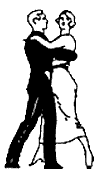|
|
The Look Of Bolero
by Harold & Meredith Sears
Rise and fall is a crucial feature of bolero. Begin each measure in a
lowered position with soft knees. Rise to a height at the end of the
long first step (the slow), lower a little for a small second step (the
first quick), and then lower more for a medium third step (the second
quick). You are now low and ready for the next side step. The rise and
fall is in the body, not in the feet and ankles. Again, step well to
the side on the slow in a lowered position. Don't rise as you step, but
step and then rise to two straight legs. The two quicks are not just a
rock and recover, but take a small step, really just placing the foot
in preparation for a substantial third step. It might feel like "step,
rise, push, crash."
A second key feature of bolero is a heaviness, an inertia, and a
connectedness between the partners, from one body, through the arms, to
the other body. So you don't just take the steps described above. You
have tone that connects you to your partner, and each helps the other
take each step. There is a dragging kind of feel and a consequent
smooth flow. Especially during the "quick, quick," he pulls and then
she pulls. Maybe it's like swinging on a double playground swing: he
pumps and then she pumps.
Third, bolero makes much use of body rotation. As you step to the side
on the left foot, rotate a little left face. As you step back with the
right, keep that rotation—we are using contra-body movement. In rumba,
you tend to dance square to your partner, but in bolero, you dance at
an angle, always rotating. Bob Powers, an accomplished ballroom
instructor, says that we don't use a lot of body sway. We don't shape
to our partners. We maintain an erect posture and turn on the long axis
of the body—always moving, always at an angle, always turning. He also
emphasizes "fast feet/slow body." During the slow count, get your foot
out there, but let the body lag behind and slowly flow over the whole
two beats. Bolero is slinky. The body never stops; it stays in motion.
From the
introduction to our bolero page and published in the Dixie Round Dance
Council (DRDC) Newsletter, October 2020.

If you would like to read other articles on dance
position, technique, styling, and specific dance rhythms, you may visit
the article TOC.
If you are not a member of DRDC,
do consider joining. The group sponsors triquarterly weekends with
great
dancing and teaching, and the newsletter is one of the most informative
available.
Past DRDC Educational Articles archived
here.
Go beyond this site. Find other references on our Sources and Links
pages.
|

